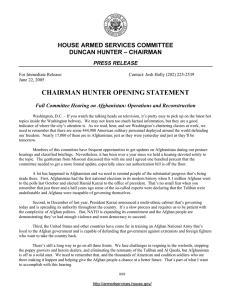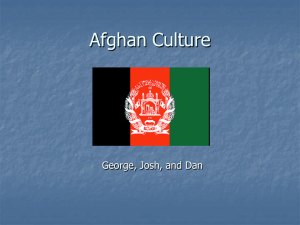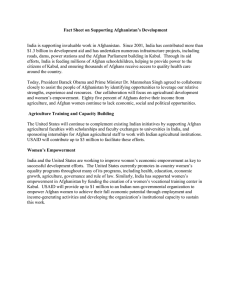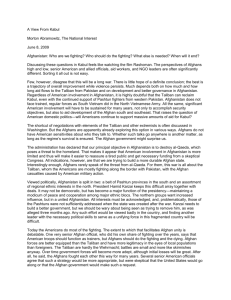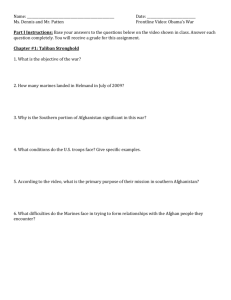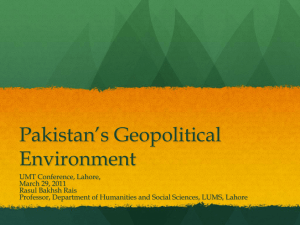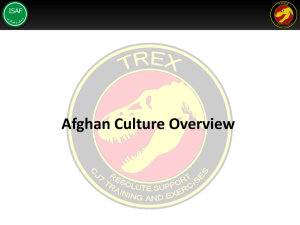A
advertisement
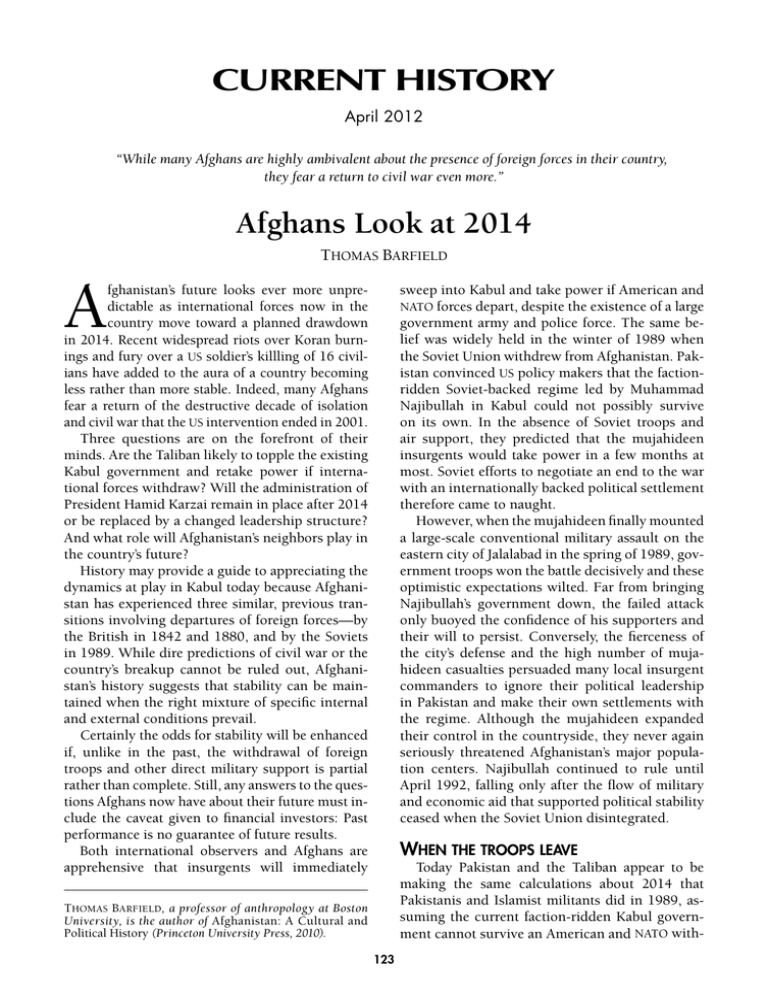
CURRENT HISTORY April 2012 “While many Afghans are highly ambivalent about the presence of foreign forces in their country, they fear a return to civil war even more.” Afghans Look at 2014 Thomas Barfield A sweep into Kabul and take power if American and NATO forces depart, despite the existence of a large government army and police force. The same belief was widely held in the winter of 1989 when the Soviet Union withdrew from Afghanistan. Pakistan convinced US policy makers that the factionridden Soviet-backed regime led by Muhammad Najibullah in Kabul could not possibly survive on its own. In the absence of Soviet troops and air support, they predicted that the mujahideen insurgents would take power in a few months at most. Soviet efforts to negotiate an end to the war with an internationally backed political settlement therefore came to naught. However, when the mujahideen finally mounted a large-scale conventional military assault on the eastern city of Jalalabad in the spring of 1989, government troops won the battle decisively and these optimistic expectations wilted. Far from bringing Najibullah’s government down, the failed attack only buoyed the confidence of his supporters and their will to persist. Conversely, the fierceness of the city’s defense and the high number of mujahideen casualties persuaded many local insurgent commanders to ignore their political leadership in Pakistan and make their own settlements with the regime. Although the mujahideen expanded their control in the countryside, they never again seriously threatened Afghanistan’s major population centers. Najibullah continued to rule until April 1992, falling only after the flow of military and economic aid that supported political stability ceased when the Soviet Union disintegrated. fghanistan’s future looks ever more unpredictable as international forces now in the country move toward a planned drawdown in 2014. Recent widespread riots over Koran burnings and fury over a US soldier’s killling of 16 civilians have added to the aura of a country becoming less rather than more stable. Indeed, many Afghans fear a return of the destructive decade of isolation and civil war that the US intervention ended in 2001. Three questions are on the forefront of their minds. Are the Taliban likely to topple the existing Kabul government and retake power if international forces withdraw? Will the administration of President Hamid Karzai remain in place after 2014 or be replaced by a changed leadership structure? And what role will Afghanistan’s neighbors play in the country’s future? History may provide a guide to appreciating the dynamics at play in Kabul today because Afghanistan has experienced three similar, previous transitions involving departures of foreign forces—by the British in 1842 and 1880, and by the Soviets in 1989. While dire predictions of civil war or the country’s breakup cannot be ruled out, Afghanistan’s history suggests that stability can be maintained when the right mixture of specific internal and external conditions prevail. Certainly the odds for stability will be enhanced if, unlike in the past, the withdrawal of foreign troops and other direct military support is partial rather than complete. Still, any answers to the questions Afghans now have about their future must include the caveat given to financial investors: Past performance is no guarantee of future results. Both international observers and Afghans are apprehensive that insurgents will immediately When the troops leave Today Pakistan and the Taliban appear to be making the same calculations about 2014 that Pakistanis and Islamist militants did in 1989, assuming the current faction-ridden Kabul government cannot survive an American and NATO with- Thomas Barfield, a professor of anthropology at Boston University, is the author of Afghanistan: A Cultural and Political History (Princeton University Press, 2010). 123 124 • CURRENT HISTORY • April 2012 drawal. They see no need to negotiate a political settlement if control of Afghanistan can be won on the battlefield once international troops depart. In fact, as in the late 1980s, negotiating a political settlement from a perceived position of strength might be the better bet for the Taliban. The historical evidence shows that, although insurgencies in the nineteenth and twentieth centuries proved effective at getting foreign troops to leave Afghanistan by wearing out the patience of the governments that sent them, they proved strikingly incapable of ousting existing governments in the aftermath of foreign withdrawals. Four structural reasons explain this lack of success. First, leaders of internationally recognized governments in Kabul continued to receive large flows of economic and military aid that far outmatched the resources available to insurgents even in the absence of foreign troops. Second, insurgents found it impossible to upgrade their unconventional warfare capacity and strategy (effective in getting foreign governments to withdraw troops) into a conventional military capacity and strategy (needed to take cities and oust governments). Third, insurgent groups that effectively mobilized local factions in support of fighting against outsiders lost their cohesion in the absence of a common foe. And fourth, insurgent leaders proved incapable of making the political transition from factional leadership to national leadership. The aftermath of all foreign invasions of Afghanistan, not just the Soviet one, displayed this pattern. Former insurgent leaders found that success on the battlefield or rallying opposition against foreigners could not be transmuted into political authority once those forces departed. None of the insurgent leaders who drove the British from the country in the nineteenth century succeeded either in taking power for themselves or in playing a prominent role in the governments of the royal British-backed emirs who invariably came to rule Afghanistan at the expense of their less well-born rivals. In fact, both of the Afghan rulers who took power in the wake of the British withdrawals in the nineteenth century, Dost Mohammad (1843–63) and Abdur Rahman (1880–1901), purged popular former insurgent leaders the instant they became troublesome. Dost Mohammad even sidelined (and some say poisoned) his own resistance hero son Akbar for being too stridently anti-British. Similarly, mujahideen faction leaders, even when they held national government positions in the 1990s, proved incapable of redefining themselves as peacemakers and restoring national unity. They could not even end the internal conflicts within their own movement, which led to a prolonged and indecisive civil war that brought the Taliban into being. The taliban in history Exceptions to this pattern emerged only when Afghan rulers had no powerful international patrons. The Taliban’s 1995 seizure of Kabul for Mullah Omar was a replay of Habibullah Kalakani’s 1929 ouster of the reforming King Amanullah. Both Omar and Kalakani successfully led reactionary factions against weak national governments that lacked access to international resources and a powerful foreign patron. While the British had earlier undermined Amanullah by denying him money and weapons, their refusal even to recognize Kalakani’s government led to his downfall after only nine months. He was replaced by Nadir Shah, a collateral member of the royal dynasty that the British did support, a dynasty that would rule a peaceful Afghanistan for the next 50 years. Although Mullah Omar found the absence of international diplomatic recognition and low flows of economic aid no bar to defeating his weaker civil war rivals, he was undone when, in the wake of the September 11, 2001, attacks on the United States, these very same rivals obtained American military and economic support. In less than 10 weeks they drove the Taliban from power and hammered out an agreement in Bonn, Germany, to make Karzai the leader of Afghanistan. This history suggests that the Taliban’s expectations of taking Kabul by force and returning to rule over Afghanistan are unlikely to be realized, at least as long as the international community chooses to support the existing Afghan government. And while the Soviets withdrew their entire military force, including advisers and air support for Afghan troops, American plans for a drawdown appear less drastic. Current US policy plans no end of air support, logistics, and training of Afghan government troops. Indeed, while discussion of a withdrawal from Afghanistan in American domestic politics stresses how many troops will be pulled out, military plans for the post-2014 period still appear to leave tens of thousands of US troops there in a “counterterrorism” role should the Afghan government agree to their presence. Such a residual international force would make it very difficult for the Taliban Afghans Look at 2014 • 125 to mount an effective conventional attack on the ments made with the same foreign governments Afghan state. The Afghans, more familiar with the that had invaded Afghanistan. But in another sense complete Soviet and British withdrawals, underit was not paradoxical at all: Foreign forces enterstandably fear abandonment by the international ing Afghanistan had one set of expectations for community, and need a clearer explanation of the type of leader they wished to support, while what will go and what will remain. foreign forces leaving Afghanistan had a decidedly None of this precludes the possibility of a coldifferent set of expectations and made their decilapse of the central government as a result of its sions accordingly. own internal weaknesses or because the Karzai The classic case of a failed ruler imposed on Afadministration attempts to broker an unacceptghanistan by outsiders was Shah Shuja (1839–42), able peace deal with the Pashtun-dominated Talwhom the British restored to the throne during the iban that alienates the non-Pashtun parts of the First Anglo-Afghan War. A feckless former king country. Should a civil war break out in the wake long exiled in India, he had persistently sought of any such central government collapse, however, British help in regaining power. Although the war the success against other regional militias that the went smoothly at first and Shuja was accepted as Taliban enjoyed in the 1990s is unlikely to be rea legitimate king, his autocratic and erratic style peated. Then the Taliban found Pakistani support of administration soon alienated both his British alone sufficient to defeat their rivals, but in any backers and the Afghan people. (Perhaps with a new war the odds would change. sense of buyer’s remorse, British officials in KaThe former Northern Alliance factions would bul expressed a much higher opinion of the emir find it much easier to gain international support they had just deposed, Dost Mohammad, than of far greater than Pakistan could hope to match. Shuja.) Moreover, Afghan history has displayed a strikAfter surviving the destruction of the British ing pattern of deal-making in Kabul garrison in the windomestic civil war situations. ter of 1842, Shuja played a Regional or ethnic factions double game. In public he avFew Afghans believe Karzai prefer to seek political settleidly supported a jihad against can manage the risks of the ments with one another raththe British while in secret he coming transition successfully. er than engage in prolonged implored them to return to fighting. For the stability sceKabul as soon as possible. nario to be feasible, however, Shuja was assassinated in history also suggests that the government in Kabul April 1842 on the day he was finally convinced needs a particular style of leadership and administo leave the safety of his heavily fortified palace trative structure quite different from the one curand six months before the British did retake Karently in place. bul. As British troops then withdrew permanently from the country, it was agreed Dost Mohammad Changing horses (now their prisoner in India) should be restored No Afghan ruler first brought to power in Kato the throne. He reigned effectively for the next bul by an invading foreign army ever succeeded 20 years before dying peacefully in control of all in keeping his job once it was decided to withAfghanistan. draw that force. However, because they could not The same pattern recurred in the Second Anglobring political stability to the country, such leaders Afghan War after the British picked Mohammad were more likely to be replaced by their frustrated Yaqub, a son of the previous emir, to rule in his foreign sponsors who had lost confidence in them deceased father’s place in 1879. Yaqub was reviled than by an Afghan insurgency. On the other hand, by the Afghans (for agreeing to territorial concesthose Afghan leaders put into power by withdrawsions) and failed the British (his mutinous troops ing foreign armies succeeded admirably in consolmurdered their resident envoy in Kabul). He abidating power. They became some of Afghanistan’s dicated before the year was out, and the British most respected (if not always well loved) leaders, signed an agreement to recognize Abdur Rahman while their predecessors were caricatured as traias emir in 1880 as they withdrew all their troops tors or foreign puppets. from the country. Over the next two decades AbIn one sense this is a paradox, since both types dur Rahman would use British subsidies and of rulers originally owed their positions to agreeweapons to crush all internal opposition and cre- 126 • CURRENT HISTORY • April 2012 ate the strongest centralized state the country had Historically, these policy changes all followed ever seen. the same trajectory. After their initial expectations A century after the British departed, the Soviof transforming Afghanistan’s political structure ets invaded Afghanistan. After killing the existing and its people proved unrealistic, the British and communist party leader, Hafizullah Amin, they Soviets became more open to letting the Afghans installed Babrak Karmal as the new head of govdo things their own way. Both great powers reernment. But Karmal was never able to establish defined their benchmarks for success downward his dominance even within the regime, let alone and reduced their policy goals to three: first, find impress the insurgents. Karmal lost his job to Naan Afghan leader with the potential to keep conjibullah in 1985 when Mikhail Gorbachev decided trol of the country with only “over the horizon” the Soviets would seek to withdraw from Afghaniassistance; second, ensure that such a leader restan. As the former head of the regime’s feared sespected their vital national interests and did not curity services, Najibullah effectively consolidated threaten them from Afghanistan; and third, be able power and, to the surprise of his Soviet backers, to blame any failures on the Afghan leader they kept his regime intact without their troops. In the left behind rather than themselves. The United end he outlasted his patrons, only agreeing to step States and its coalition partners now seem to be on down in 1992 after the Soviet Union dissolved. a similar path, and Afghans are considering how Unable then to escape the country, Najibullah they should adapt to this changing environment. sought refuge in the United Nations mission in Karzai’s fate Kabul, where he was later murdered by the TalAlthough initially a far more popular choice iban in 1995. than his predecessors—and one who sought doThere is a clear pattern in all of these comparimestic approval through a series of consultative sons. Foreign forces preferred to back weak perassemblies and elections— sonalities for leadership Karzai has displayed many when they entered Afghaniof the characteristics of the stan but strong ones when As international powers become less other Afghan rulers brought they left. Leaders with no involved, Afghans worry how their to power by foreign forces. secure power base within immediate neighbors will respond. He has been indecisive and the country were willing to rarely able to make hard meet the demands of their decisions. He is easily influforeign backers to clear enced by those around him and responds poorly to other rivals from the field. While this eventually criticism, dismissing ministers who appear too inundermined their political legitimacy within Afdependent. Although the constitution grants him ghanistan, their positions were secure as long as strong executive powers, he refuses to take steps the foreign troops remained in the country. (Shuto curb the pervasive corruption and mismanageja, Yaqub, and Karmal never displayed any conment that undermine the Afghan state and its lefidence that they could remain in office without gitimacy. His genuinely popular victory in the first such support.) Afghan presidential election of 2004 was overThe problem was that no foreign government shadowed by the massive fraud that accompanied was willing to maintain a long-term occupation if his reelection in 2009. it was too costly or required too much fighting. In Because his government is protected by internaboth Anglo-Afghan wars and the Soviet invasion, tional forces, Karzai sees little need to compromise it was presumed that a successful invasion alone politically, to share authority, or to face unpleasant would defeat the opposition and impose order. realities, even when doing so would serve his own Any troops left behind would have only garrison long-term best interest. And he has a habit of disduty. As a result, they were ill prepared for the inplaying his independence by periodically attacksurgencies that arose later, and their home governing the very alliance that protects his government. ments eventually decided to shift to policies of inThis has only irritated his international backers direct support. This meant changing the existing without improving his reputation among the Afleadership for one that was more robust and stood ghan people. a better chance of going it alone (as Dost MohamA good example was his surprising declaration mad, Abdur Rahman, and Najibullah succeeded in in October 2011 that “if fighting starts between doing). Afghans Look at 2014 • 127 Pakistan and the US, we are beside Pakistan.” This offended the Americans and amazed the Afghans, most of whom have little affection for Pakistan regardless of their political affiliation. Taliban propaganda labels Karzai the American Shah Shuja, an unfair but deeply cutting comparison. Whatever his weaknesses, President Karzai’s ability to keep his government intact for 10 years has been no mean feat. However, he has accomplished this in a political environment where foreign aid is ever flowing and international forces are at the forefront of fighting against the Taliban insurgency in the south and east. As long as this status quo persisted there was no reason to think Karzai could not rule indefinitely. But while the government in Kabul in the first decade of the twenty-first century received unquestioned and continuous support from the international community, this willingness has waned in the second decade. The cost of a seemingly unending Afghan war in both lives and money has rapidly undermined international support for Karzai’s government. No one in the international community wants to see the Taliban return, but the option of continued unlimited assistance for Afghanistan has grown increasingly difficult to sell to domestic electorates in the European Union, Canada, and the United States. Even so, if announcing plans to leave Afghanistan was designed to calm these audiences, it has had the opposite effect on the Afghans. However much Karzai’s government has failed to meet their expectations, most Afghans are far better off than they were in 2001, and they do not want to see this progress lost. While many Afghans are highly ambivalent about the presence of foreign forces in their country, they fear a return to civil war even more. International plans to meet Afghanistan’s security needs post-2014 are currently focused on building a larger Afghan army and police force. No similar attention has been devoted to reforming civil administration—the unaddressed half of the security situation—the defects of which the Taliban have long exploited. In any event, few Afghans, whether friends or foes, believe Karzai is the kind of leader who can manage the risks of the coming transition successfully. While the British and the Soviets had no hesitation in sacking one leader and installing another better prepared to run Afghanistan on his own, the democratic system put in place by the international community now appears to forestall that policy option. But not entirely: The 2004 constitution limits an Afghan president to two terms, and Karzai’s second will expire in 2014, coinciding with the transfer of responsibility for security to the Afghan government from international forces. Afghans are therefore asking themselves if the United States and its allies will encourage the use of this democratic avenue to press for a change in leadership in Kabul to coincide with their troop withdrawals. Karzai himself has proclaimed on a number of occasions that he will respect the constitution and not seek an extension of his term. Still, no Afghan ruler has ever relinquished power voluntarily, so Kabul is rife with speculation that Karzai intends to stay on regardless of the constitution. History suggests that this would be a mistake, but it is doubtful that Afghanistan’s international partners have the skill (or hubris) needed to pick a leader who is both effective and legitimate in Afghan eyes. And perhaps they should not try. The advantage of the democratic system now in place is that it is up to Afghans to take on that role. They have two years to work through political and logistical issues before a new president must be chosen, and this transition should be highlighted as much as changes in international policy over the same period. A robust and open political debate would be the surest evidence that the necessary changes in leadership and government structure can be made, and made in time. Friends and neighbors Afghanistan for long periods maintained its political stability by carefully cultivating international ties. In the nineteenth century it kept its independence by serving as a buffer state between British India and Czarist Russia, and it maintained this policy even after Russia became the Soviet Union in the twentieth century. One consequence of this was that Afghanistan had no reason to develop a regional diplomatic policy. (Iran, its only other neighbor, had long been excluded from Afghan affairs by the British and the Russians.) This first changed in 1947 when the British withdrew from South Asia and then after the Soviet Union collapsed in 1991. The British left behind not one but two successor states (India and Pakistan), and the Soviets left three new contiguous states on Afghanistan’s northern border (Turkmenistan, Uzbekistan, and Tajikistan). By the late 128 • CURRENT HISTORY • April 2012 1970s Iran under the Shah had become much more developed and politically powerful, and it remained so under the Islamic Republic. Today Afghanistan’s relationship with Iran and the postSoviet states is generally good, with few points of contention. The same cannot be said of Pakistan, which has long sought to control Afghanistan as a client state, a goal that it achieved when it helped the Taliban gain power but lost after the Americans drove them from the country. Today, as international powers seek to become less involved in the country, Afghans worry how their immediate neighbors will respond. Pakistan already provides sanctuary and aid to the Taliban. It has made clear its desire to see them back in power in Kabul. Afghans therefore view Pakistan as their most disruptive neighbor, as well as the only one with which they have an unresolved territorial dispute. (No Afghan government has ever recognized the Durand Line drawn by the British in 1893 as a legitimate border.) Pakistan is also determined to keep Indian influence in Afghanistan to a minimum and is willing to interfere in Afghan politics to achieve this end. By contrast Afghanistan’s other immediate neighbors have only a marginal interest in its internal political affairs and a much stronger desire to see the country stable. Iran’s leaders are opposed to any radical Sunni political movement taking power in Kabul because of the danger it would pose to their Shiite state, and they have invested heavily in western Afghanistan. The secular leaders of the post-Soviet Central Asian states fear the spread of extremist Islamic movements of any sort, and would like to use Afghanistan as a new transit route for energy and overland trade. China, which has a tiny border with Afghanistan, sees political instability and civil war as obstacles to its own development of the country’s rich mineral deposits. Despite Pakistan’s objections, India is currently increasing its economic and political footprint in Afghanistan. It does not wish to see Afghanistan again serve as a base for radical Islamic terrorist groups, as it did under the Taliban, since these attacked Kashmir and carried out operations in India itself. Like China, India also sees the development of Afghan resources as a potential boon to its own rapidly growing economy. (India has completed a highway through Iran that for the first time links Afghanistan to ports in the Persian Gulf, and has spent over $600 million building domestic roads and electric lines as well as building schools.) With the exception of the Taliban, all Afghan governments have had closer relations with New Delhi than Islamabad. The Afghan government is also aware that India and China are regional powers on the rise economically and militarily, and able to provide development aid to replace what will be lost as Western nations reduce their profile. Pakistan, by contrast, has a weak economy with little capacity for major investments in Afghanistan. Two scenarios These regional relationships have all been overshadowed by Afghanistan’s focus on the United States and NATO countries, but they are now getting renewed attention in Kabul. What creates uncertainty is that two possible scenarios present themselves, one very positive and one very negative, and both look equally plausible at the moment. In the positive scenario, Afghanistan’s neighbors push for peace and stability in their own self-interest. Even Islamabad would find it hard to sustain a policy of disruption if Pakistan became dependent on new supplies of natural gas from Turkmenistan or hydroelectricity from Tajikistan—all of which would have to pass through Afghanistan. Similarly, Pakistan’s “all-weather ally” China would not look happily on any attacks on its people or its mining investments in Afghanistan by insurgents based in Pakistan. In this scenario, whether Pakistan likes it or not, India likely becomes the key ally of Afghan governments in Kabul simply because it can bring vastly more resources to bear, and because the Afghans could use the relationship to balance off both Chinese and Pakistani pressures in the way they played off other powers in the past to preserve their independence. The negative scenario is a gloomy one indeed. In it Afghanistan becomes the battleground for a new proxy war between India and Pakistan. Afghanistan again enters into a civil war in which these two neighbors (and others) arm and fund various ethnic and regional allies, plunging the country back into the misery it experienced in the 1990s and from which it escaped in 2001. Benjamin Franklin wrote that creditors have better memories than debtors. It might be said that Afghans have a sharper sense of international relations than their more secure neighbors or international allies. The questions they ask today deserve more attention and better answers. ■ “Managing New Delhi’s participation in the Afghan endgame will be critical, and it will require a review of US-India policy in Washington.” The Fate of India’s Strategic Restraint Sunil Dasgupta I n February 2012, India selected a French jet, the Rafale, as the new mainstay fighter for its air force. A month earlier, the country had leased a nuclear submarine from Russia. The acquisition of the fighter aircraft and submarine is part of an ambitious military modernization that has made India the number one arms importer in the world. This rearmament effort, riding on the nation’s unprecedented economic growth, has prompted some observers to wonder whether India has decided to balance Chinese power in Asia or is seeking to correct the anomaly of strategic parity with Pakistan, a country one fifth its size. Indians themselves want their country to act more assertively, and India’s primary rival, Pakistan, has never bought into neighborly restraint. So, could we be witnessing the start of an IndiaChina arms race in Asia that would become the defining global conflict of the twenty-first century—as the United States returns to its traditional role of offshore balancer, reduces its overseas presence, and husbands resources for domestic recovery? Could we also be standing on the precipice of a nuclear confrontation with Pakistan? The answer is: Probably not. India’s rearmament efforts are unlikely to turn the nation into an aggressive power, seeking military balance with China and upending the existing balance with Pakistan. Indeed, not only have India’s political leaders traditionally hesitated to use force as an instrument of foreign policy even when the conditions were right for it, they have neglected to provide clear strategic guidance to the military. In a 2010 book, Stephen P. Cohen of the Brookings Institution and I called this phenomenon “arming without aiming.” We found that the disconnect between strategic purpose and military planning is both shaped by and reinforces military-strategic restraint in India’s foreign policy. Today, notwithstanding growing uncertainty in South Asia and the recently accelerated arms buildup, New Delhi appears unlikely to abandon this military restraint. Certainly, fears of American withdrawal from the region are making Indians jittery about a resurgence of terrorist threats. At the same time, New Delhi likely will strive to wield its growing economic and international influence in Afghanistan as US troops pull out. Although India’s engagement probably will not rise to the level of military intervention, it might be sufficient to fuel another dangerous rivalry with the Pakistanis in Afghanistan. Outside of an unlikely new war, however, India’s political leaders will not want to spend the political and monetary capital necessary to transform growing resources into military power and purpose sufficient for a reordering of their country’s strategic condition. This is not a pessimistic view of India’s prospects in the world. To the contrary, military-strategic restraint has paid off handsomely despite the resulting inefficiencies in defense planning. Restraint has contributed to greater accommodation of India’s rise as a great power in the international community. The rise of China led Singapore, for example, to exhort India to become more engaged in Southeast Asia. Today, even the Russians hesitate to sell advanced weapons to China, but Western firms want to be part of India’s military revival. They are motivated by profit, of course, but also by the recognition that India is unlikely to become hostile to their own nations’ interests. Most notably, the US-India Civil Nuclear Cooperation Agreement, based on a framework agreed Sunil Dasgupta is director of the political science program at the Universities at Shady Grove, part of the University of Maryland–Baltimore County, and a non-resident senior fellow in foreign policy studies at the Brookings Institution. He is co-author, with Stephen P. Cohen, of Arming Without Aiming: India’s Military Modernization (Brookings Institution Press, 2010). 129
